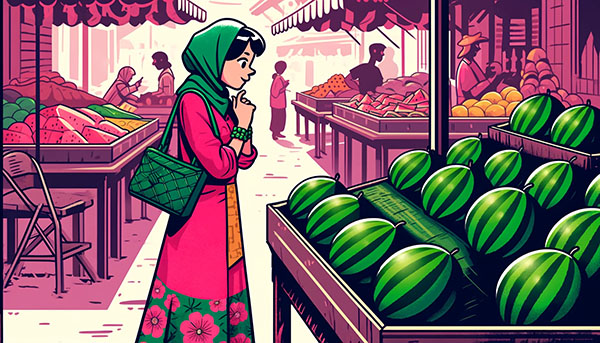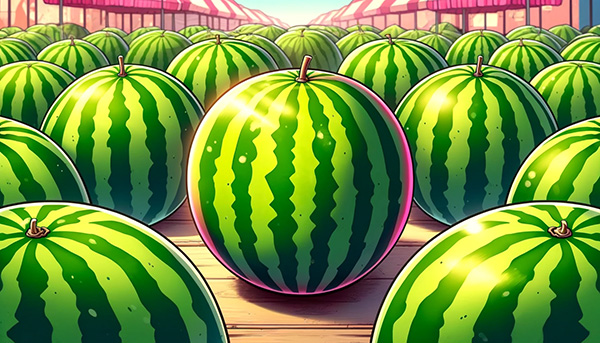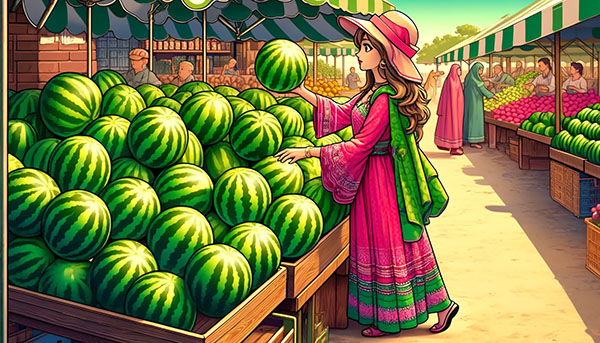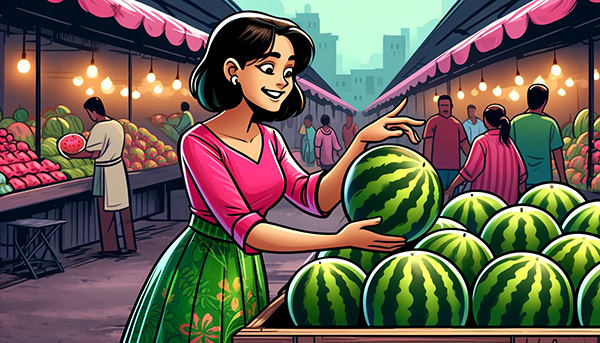As the sun's rays grow warmer and the days longer, one iconic fruit takes center stage at summer gatherings and picnics—the watermelon. The watermelon embodies the essence of summertime indulgence with its juicy, refreshing flesh and vibrant green exterior. But how do you pick the best watermelons amidst a sea of green and striped contenders?
Fear not, because in this comprehensive guide, we'll share how to pick a good watermelon this watermelon season. From understanding the subtle signs of ripeness to tapping into the secrets of choosing the juiciest melon, you'll be well-prepared for your next uncut watermelon shopping at a farmers market or local grocery store so you can enjoy this delicious fruit or turn it into a watermelon salad. If you are seeking to pick a good yellow watermelon, the basic principles of selecting a watermelon are the same, with some color differences.
How To Pick A Good Watermelon
1. Examine the Color

The color of a watermelon's skin is the first clue to its ripeness. A ripe, sweet watermelon typically boasts a rich, uniform green color with a green stem and lighter green stripes. Look for one that doesn't have any faded or dull areas.
Variations or irregularities in color may suggest uneven ripening, which can impact the fruit's taste and texture. The green should be consistent throughout the fruit. Color variations can indicate uneven ripening. Irregular striping can sometimes be an indication of uneven ripening as well.
2. Check for a Uniform Shape

A symmetrical shape is an indicator of even growth and ripening. Irregularities in shape, such as flat sides or lopsidedness, might suggest inconsistencies in ripening, so opt for a watermelon that appears well-proportioned.
While slight variations in shape are normal due to the natural growth patterns of watermelons, you should aim to select one that is as close to symmetrical as possible. This attention to detail in evaluating the watermelon's shape and other key factors like color and sound will help you pick a watermelon that promises the sweet, refreshing goodness we all crave on hot summer days.
3. Look for the Sugar Spot
The sugar spot, sometimes called the "ground spot," is a creamy or yellowish area on the watermelon's skin where it rested on the ground while it ripened in the sun. These spots are a sign of sweet melon. The deeper and more pronounced the sugar spot, the better the chances that the juicy watermelon bursts with flavor.
In contrast, a pale or white sugar spot may suggest that the watermelon isn't fully ripe, potentially resulting in a less sweet and enjoyable eating experience. So, when shopping for the best watermelon, embrace those beautiful sugar spots as a delightful indication that you're likely to savor a slice of summer's sweetest goodness.
4. Inspect the Skin Texture
Examining the skin texture of a watermelon is a crucial step in pursuing perfection. A ripe watermelon should have relatively smooth skin and no irregular bumps. While it's not uncommon to find minor scratches, scuffs, or small blemishes on the skin, you should avoid watermelons with significant or soft spots, as these can be indicators of overripeness or damage.
The skin of a watermelon serves as a protective barrier for the succulent flesh inside. A smooth, intact skin usually indicates that the fruit has developed properly and is less likely to have been compromised during its growth and harvest.
As you run your fingers across the watermelon's skin, seek out those that offer a consistent texture without major imperfections. This attention to detail in assessing skin texture, combined with other factors like color and shape, will lead you to the perfect watermelon – one that's not only visually appealing but also promises a mouthwatering, sweet, and refreshing taste, making it a true star of your summertime festivities.
5. Look for a Dull Sheen
A shiny watermelon isn't necessarily ripe. In fact, it might still be underripe. A ripe melon will have a slightly dull skin. The matte appearance often signifies that the fruit is ready to be enjoyed, so be sure to pick a dull-looking watermelon.
6. Pick It Up

When selecting the perfect melon, one of the simplest yet effective methods is to pick it up. A ripe watermelon should have a substantial weight relative to its size. This weight results from its high water content, making it juicy and delicious.
As you reach for a watermelon, compare its weight to similar-sized ones nearby. The heavier the watermelon feels, the more likely it is to be ripe and full of sweet, refreshing juice. On the contrary, if a watermelon feels disproportionately light for its size, it might indicate underripeness.
Picking up a watermelon also allows you to assess its density and firmness. You'll want a solid and firm watermelon that is not overly hard. When gently pressing your fingers into the skin, a slight give can signify ripeness.
7. Give It a Thump

A ripe watermelon should produce a distinct, deep sound, and hollow sound when you tap it. This is often described as a "dull" sound, indicating that the fruit is full of water, contributing to its juiciness and sweetness. Think of it as the watermelon saying, "I'm ripe and ready to enjoy!"
Conversely, if the sound is excessively sharp or high-pitched, it might indicate that the watermelon is underripe. On the other hand, if the thump is dull but sounds somewhat "flat," it might suggest overripeness, which can result in a mushy texture.
8. Check the Field Spot

The field spot is the portion of the watermelon that was directly in contact with the ground during ripening in the sun. It's usually located on the underside of the fruit.
A well-developed field spot is a valuable indicator of a watermelon's ripeness and sweetness. It should have a deep, creamy yellow, dark yellow, or even orange hue. The more vibrant and richly colored the field spot, the better. This coloration suggests that the watermelon had ample time to bask in the sun, allowing its sugars to develop fully.
Conversely, a pale or white field spot may suggest that the watermelon was harvested prematurely and might not have reached its peak sweetness.
FAQs
Can I ripen an under-ripe watermelon at home?
Watermelons don't ripen significantly after being picked. While you can improve the texture by leaving it at room temperature for a few days, it won't significantly increase in sweetness. It's best to select a ripe one from the start.
Should I choose a heavy watermelon?
Yes, a heavier watermelon for its size is usually a good sign. The weight of a watermelon signifies a high water content, which is associated with juiciness and sweetness.
What should I avoid when selecting whole watermelons?
Avoid watermelons with significant blemishes, soft spots, flat sides, or irregular shapes. These characteristics can be indicators of ripening or quality issues.
What are the best storage practices to keep a watermelon juicy once I've bought it?
After buying an uncut watermelon, store watermelon in a cool, dry location until you're prepared to eat it. Once it's sliced, store any remaining cut watermelon in an airtight container in the refrigerator to preserve its juiciness.
Is there a specific season when watermelons are the sweetest?
Watermelons are generally sweetest during their peak season, which varies by region but is typically in the summertime. However, some regions produce extra sweet watermelon earlier or later in the year.
Can I tell the ripeness of a watermelon by its stem?
Some people believe that the stem of a watermelon can indicate ripeness, but this method is not always reliable. It's better to rely on other indicators like color, field spot, and sound.
Can I judge a watermelon's ripeness by its scent?
While a faint, sweet aroma can signify ripeness, it's not always a reliable indicator. The other methods mentioned, like color and texture, are more accurate.
What is the significance of a cracked watermelon?
Cracks in the skin of watermelon can indicate fluctuations in temperature or moisture during growth. Small, superficial cracks may not affect the quality, but deep or extensive cracks could suggest overripeness or drying out.
